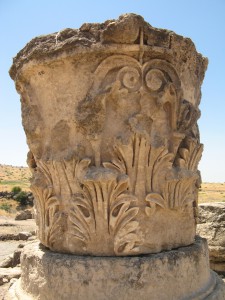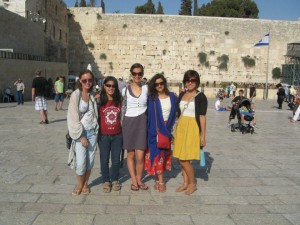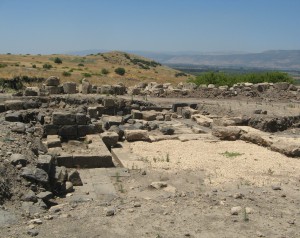So pleasant was the after-dinner lull two Fridays ago, my insides warmed by fragrant tea, that the beginning of the Muslim call to prayer over Jerusalem almost startled me. The same hauntingly beautiful cries had accompanied the team’s exit from the Church of the Holy Sepulcher that afternoon, at a high point of our day trip to the Old City. Only now, however, did they set my mind in motion. As I admired the dusky Temple Mount from our rooftop restaurant, they made me aware of the rhythm of Jerusalem’s daily life, a rhythm shaped and yet not fully shared by the pilgrims and other visitors who for centuries have flooded this place. How exciting it’d be to live in such a concentrate of history, I couldn’t help imagining.
But perhaps, I sighed to myself, the thrill of the old would soon fade into indifference. I thought of the kibbutz that’s hosting us for the dig season, where one resident uses a column capital from nearby Omrit as a lawn table. Then again, how correctly was I judging the attitude of those who’ve long lived among ancient remains? And should these inhabitants even be expected to treat those remains as if they were museum property? In a country like Israel, the very idea of which has radically different meanings to different groups, the remote past seems after all as much a living subject as the recent one, a subject to grapple with and rewrite more than timidly guard.
The feeling in such a country toward the remnants of antiquity would thus transcend the scale between apathy and enthusiasm, I dared conclude. Those remnants would be no more and no less than part of the fabric of existence there, akin to the language and cuisine. The spoliation I saw at Kibbutz Kfar Szold could itself be viewed, then, as part of a tradition that originated (at latest) in the Byzantine repurposing of Roman stone. I realized that while my reflection had begun on the surface of life in Jerusalem, my travel experience, if terribly limited, had maybe allowed me a glimpse of something deeper. Realizing also that this couldn’t be more than a glimpse for now, I rose from the dinner table with a tourist’s typical, melancholy yearning to leave a piece of herself behind.

On the temple podium at Omrit, a Corinthian capital virtually identical to the one I saw at Kfar Szold.


